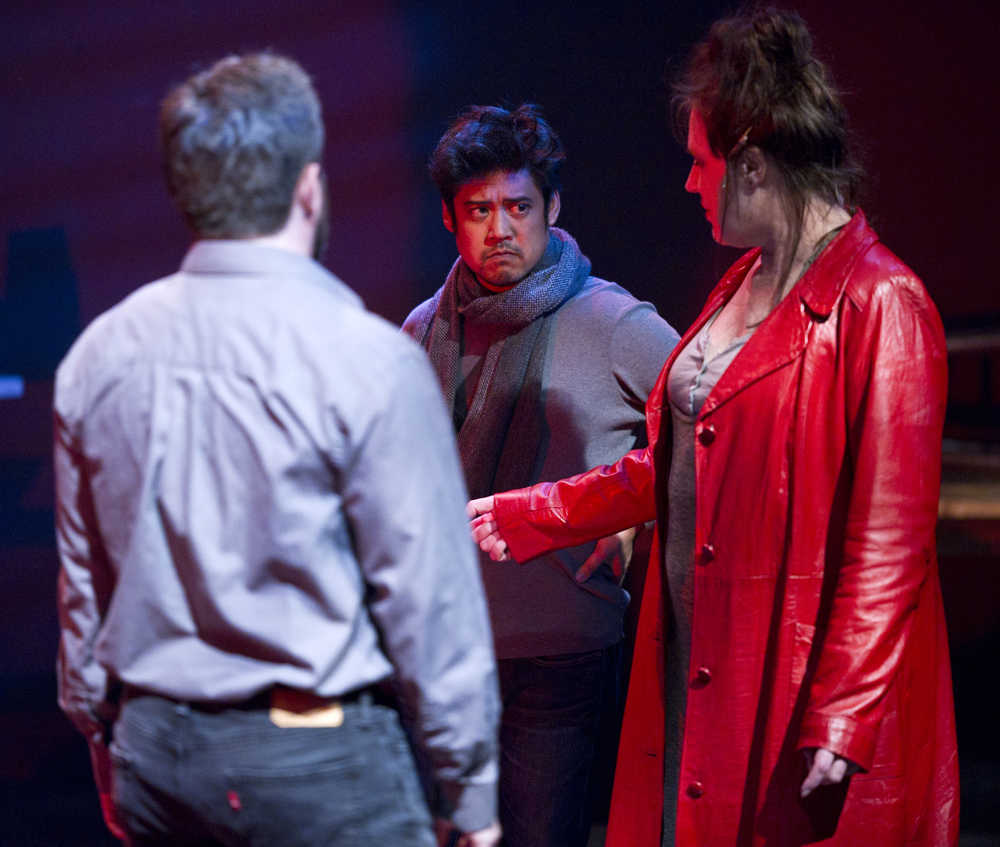“The history of the world, my sweet, is who gets eaten and who gets to eat.” – Sweeney Todd
Bon appétit, Juneau. But beware. The piquancy of Perseverance Theatre’s rendition of Stephen Sondheim’s “Sweeney Todd: the Demon Barber of Fleet Street” definitely sneaks up on you. It’s kind of like theatrical Sriracha.
Let’s not mince words, here. “Sweeney Todd” isn’t a particularly pleasant musical—at least not in the traditional sense. Plot points include rape, incest, murder and cannibalism. The score, based upon a Catholic death mass, is complex, choppy and often purposefully dissonant, as if to keep the audience in a state of constant tension. And the lyrics echo with such lines as “there’s a hole in the world like a great black pit, and it’s filled with people who are filled with [ahem].” This isn’t “I feel pretty and witty and gay” Stephen Sondheim; it’s “we all deserve to die” Stephen Sondheim.
Of course, there’s a certain masochistic enjoyment to be found in the unpleasant, which, come to think of it, may be the whole point.
Director Flordelino Lagundino serves up this penny-dreadful tale of gruesome revenge and grotesque desire simmering in a broth of perverse social injustice. Set in a less-than-savory neighborhood in 19th century London, “Sweeney Todd” tells the story of a master barber unjustly convicted and shipped off to Australia by a wicked, lecherous judge who not only covets his wife, but also steals his baby daughter. The ex-con returns 15 years later as Sweeney Todd, seeking retribution by slashing the throats of his tonsorial customers, who are then disposed of via custom barber chair and processed into meat pies by opportunistic downstairs baker Mrs. Lovett. Talk about farm-to-table.
“Sweeney Todd” ranks as one of Sondheim’s most-produced musicals. Given its combination of black humor and graphically violent subject matter, productions of “Sweeney Todd” often veer off into spectacle, dripping with low-budget slasher-flick style special effects.
Perseverance’s production, however, is far more restrained in its theatrics. Here, Lagundino eschews the usual grisly splatter. Carnage is either implied or evoked through lighting; sets, designed by Deb O, share similar “steampunk” sparseness.
This “Sweeney Todd” tastes more like sardonic social commentary than live-action horror show. Without all the blood, the audience focuses on the razor. What’s truly more frightening, the musical seems to ask, campy gore or the depths of human ruthlessness?
Of course, without large set pieces and spurting jugulars—even the song-and-dance numbers seem intentionally muted — the show relies heavily upon the strength of its performers.
Perseverance actor-in-residence Enrique Bravo delivers a haunting turn as the Demon Barber. His eyes burn with monomaniacal hatred when he talks about murder; he performs the actual slashing with eerily casual abandon. Victoria Bundonis, who you may recognize from Showtime’s “Nurse Jackie,” gleams as Mrs. Lovett, the cannibal pie-woman. She is ghoulishly funny—her character gets the biggest portion and choicest cuts of humor—and raggedly erotic… like a Victorian-era “cougar.”
Beyond this gruesome twosome, Keith Patrick McCoy is thrillingly chilling as Judge Turpin (and his singing voice buttery and deep; I’m jealous). In Leonid Grinberg’s Anthony, star-crossed lover of Sweeney Todd’s daughter, I noted hints of Tony from “West Side Story,” for which Sondheim wrote the lyrics. Jessica Skiba holds her own as Johanna, the daughter in question, as does Zebadiah Bodine as Tobias Bragg, Kelly Rossberg as the Beadle and Christina Apathy as the Beggar Woman, whose refrain, “city on fire,” still haunts me nearly a week after opening night.
Indeed, the ensemble plays a large role in “Sweeney Todd,” acting as a classical Greek chorus (in addition to eventual pie filling). The entire cast opens the second act with perhaps the musical’s most demanding number, “God, That’s Good,” in which the people of London—specifically the underclass people of London—become enamored of Mrs. Lovett’s new menu offering. Obvious message: it’s not only dog eat dog out there; it’s people eat people.
By no means am I calling “Sweeney Todd” a perfect production. Some elements — such as the intrusion of objects like Casio keyboards and Converse Chuck Taylor All-Stars into Victorian England—seemed oddly anachronistic, as did the decision to include video art, which I found unnecessary and distracting… but then, I find most video art to be unnecessary and distracting. Still, that sort of thing runs counter to the show’s otherwise pervasive minimalist aesthetic.
And, of course, the gore is part of the fun. Like sprinkling sugar on grapefruit, dousing “Sweeney Todd” in buckets of stage blood can actually sweeten a musical some may otherwise find too bitter to handle on its own.

